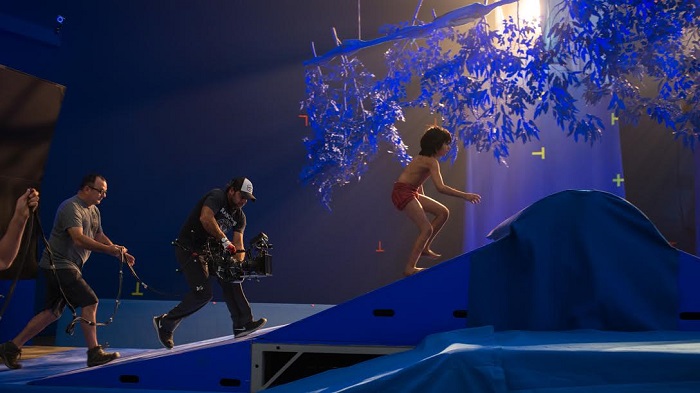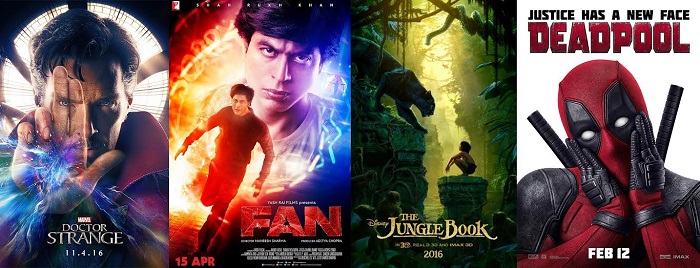The year 2016 will go down in history as the year where visual effects once again redefined how stories are told on the big screen. It’s common knowledge that VFX has become a part and parcel of the production cycle for a feature film over the years, but there comes a time every now and then when a certain project propels VFX to the forefront of things.
2016 saw few feature films – The Jungle Book, Doctor Strange and Deadpool – that have redefined the way a filmmaker can envision the story on celluloid using the wizardry of VFX. Other features that did manage to leave a mark were FAN, Alice Through The Looking Glass, Kubo, Captain America: Civil War and X-Men: Apocalypse.
Speaking about The Jungle Book in particular, the way in which the entire movie has been visualized is praise worthy; right from the diverse scenic environments which can be experienced throughout the duration of the film to the intricate detailing for the expressions and actions of the various animals seen. After Life of Pie (2012), this feature has raised the bar in terms of achieving unimaginable photorealism by seamless use of visual effects. The level of detailing that has gone into recreating the digital environments based on real life references, while also ensuring that the young boy playing Mowgli is able to interact with the props that represent various characters in the movie is mindboggling. The approach that the VFX team took for achieving the seamless look and feel is the real winner; Simulcam technique was used for combining puppet character props interacting with Mowgli on set against the Chroma screen while the director could view low-resolution computer generated characters and the environment around them on a screen during principle photography stage for perfecting the shots.

On the other hand Doctor Strange used VFX to experiment with implausible visuals to push the boundaries of realism into creating a world of sorcery and wizardry using kaleidoscope effects. The kind of VFX carried out here were as trailblazing as the ones we experienced in the noir genre of cinema like The Matrix (1999) and more recently Inception (2010).
The Deadpool’s action opener where the time slice technique is beautifully used for creating an entirely computer generated car chase sequence for the title credits has been immaculately crafted. Since the entire sequence had to seem as if its shot in real time, the VFX studio had the daunting task of not only creating a computer generated environment to show the cityscape and a busy freeway, but also create CG models of the characters involved in the sequence as it would have been impossible to shoot against Chroma when cars and bikes are colliding in real time. Thus, due credit goes to the studio for helping the director capture this sequence for the opening credits of the movie and set the tone for the pulsating action to follow.
And with FAN, an Indian VFX studio (redchillies.vfx) left its impact on the global frontier by making possible something which was never attempted at this scale where an actor was de-aged and also shrunk in size frame by frame for the entire duration of 120 minutes.

The other noteworthy VFX heavy sequences from Hollywood were: Kubo’s seamless amalgamation of stop-motion animation technique with VFX to narrate the tale of a young boy fascinated with telling stories using Origami; and the entire destruction of Egypt which was carried out using proprietary software Kali and involved over 1000 artists working on it.
As for my projections for the year 2017 – Well I can comfortably say that Indian VFX industry is ready to rub shoulders with our friends globally and create content that would continue to raise the bar for visual effects. Earlier the kind of work that primarily was outsourced to Indian studios were BG Prep and Clean Up work, but over the past few years Indian artists have been entrusted with intense Compositing and FX work as well for Hollywood big budget tent-poles and superhero movies. While in the past work was outsourced to India keeping the bottom line of the studio in check, nowadays the scenario is such that work outsourced to India is purely based on the valuable skills and expertise that the artists can bring to the table, which they have gathered over the years.
And with more VFX heavy content being created for not just movies, but television as well as OTT/VOD platforms like Hulu and Netflix, it further creates a whole new avenue for VFX studios globally to showcase their technical and creative prowess!
(These are purely personal views of Redchillies VFX, CCO and VFX Supervisor, Harry Hingorani and AnimationXpress.com does not necessarily subscribe to these views)
